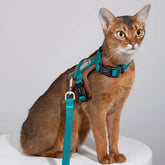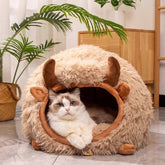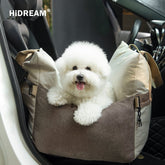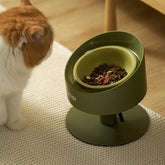The Complete Guide to Cat Petting

Cats have captured the hearts of millions of people around the world with their grace, independence, and charming personalities. As a cat lover, you know that each feline friend has its own unique character, but one thing remains consistent: they all love a good petting session! However, not all cats enjoy the same type of touch, and understanding their body language is essential to ensure a happy and comfortable experience for both you and your furry companion.
Whether you're a seasoned cat parent or welcoming a new feline into your home, this guide will equip you with the tools to navigate the complexities of cat communication and respond to their needs with empathy and care. Understanding your cat's non-verbal cues is the foundation of a strong and harmonious relationship, promoting a sense of trust and security that will lead to endless moments of joy and companionship. Embrace this enlightening journey of feline understanding and embark on a path to strengthening the bond with your beloved cat like never before.
The Language of Cats: Decoding Feline Body Signals
Before diving into the world of cat petting, it's crucial to understand how cats communicate through their body language. Learning to read their signals will help you identify when your cat is in the mood for affection and when they need space. Some key body signals include:
Tail Position
A cat's tail position speaks volumes about its emotions and intentions. A tail held straight up signifies a confident, content cat, while a horizontal tail shows relaxation. A slightly lowered tail indicates curiosity or uncertainty, while a tucked tail reveals fear or submission. A puffed-up tail signifies aggression or threat, and a wagging tail may denote agitation or excitement. Quivering tail tips suggest anticipation, while wrapping their tail around you expresses affection and trust.
Ears
When the ears are upright and facing forward, the cat is attentive and curious about its surroundings. Ears slightly tilted backward may indicate a relaxed and content mood. However, if the ears are flattened against the head, it's a sign of fear or agitation, suggesting the cat feels threatened. Furthermore, rapidly swiveling ears may show heightened alertness or excitement.
Eyes
When a cat's eyes are fully open with pupils constricted, it indicates a calm and content state. Dilated pupils may suggest excitement, fear, or arousal. Slow blinking is a sign of trust and affection, often referred to as a "cat kiss." Staring with dilated pupils, on the other hand, can be perceived as a challenge or a threat in the feline world. Half-closed eyes may mean relaxation and comfort, showcasing their trust in their environment. Purring: Generally a sign of contentment, though cats may also purr when anxious or in pain.
Body Posture
A cat's body posture conveys a wealth of information about their emotional state. When a cat stands tall with a relaxed body, it shows they feel secure and comfortable. Arched back and fur standing on end indicate agitation or fear, as they try to appear larger to ward off potential threats. A crouched position with tense muscles signals readiness to pounce or a sign of uncertainty. Rolling onto their back, exposing their belly, can indicate trust and vulnerability, but it's important to note that not all cats enjoy belly rubs. A tense and stiff body with ears flattened and tail twitching may signify annoyance or aggression.

Building Trust and Creating a Safe Environment
Building trust is essential to fostering a strong bond with your cat. Here are some tips to create a safe and comfortable environment for your feline companion:
Patience
Allow your cat to approach you on their terms. Avoid forcing interaction and let them come to you when they feel ready.
Safe Spaces
Cats need places to retreat to when they want alone time. Provide cozy hiding spots or a cat tree where they can feel secure.
Positive Reinforcement
Reward your cat's affectionate behavior with treats or gentle strokes. Positive reinforcement will encourage more interactions.
Respect Boundaries
Respect your cat's personal space, especially when they show signs of discomfort or agitation.

Techniques for Successful Cat Petting
Now that you understand feline body language and have built trust with your cat, it's time to master the art of cat petting. Here are some effective techniques:
Chin and Cheek Rubs
Most cats enjoy gentle chin and cheek rubs. Use your fingers to stroke their chin and cheeks in slow, circular motions.
Head and Neck Strokes
Gently stroke your cat's head and neck in the direction of their fur. Avoid petting against the grain, as it may cause discomfort.
Under-Chin Scratches
Cats often love scratches under their chin. Use your fingers to scratch the soft skin under their jaw.
Tail Strokes
If your cat enjoys having their tail touched, use light strokes along the length of their tail.
Belly Rubs
Some cats love belly rubs, but not all do. Approach this area with caution and stop immediately if your cat shows signs of discomfort.

Signs Your Cat is Not Enjoying Petting
Cats communicate their feelings through body language. Learn to recognize warning signs that your cat may not be in the mood for petting. Dilated pupils, swishing tail, flattened ears, or an attempt to move away are indications that your cat wants some alone time. It's essential to recognize signs that your cat is not enjoying the petting session. Some signs include:
Tail Flicking
When a cat's tail is flicking, it typically signals a mix of emotions such as irritation, agitation, or impatience. The flicking motion is a way for cats to release pent-up energy or express their discomfort with a situation. It could be a warning sign that they are feeling overstimulated during petting or play, and continuing the interaction might lead to an unfavorable reaction. Additionally, flicking may also indicate a playful mood, especially if paired with other playful behaviors. Ears Flattened Back: Flattened ears signal discomfort or displeasure.
Hissing or Growling
When a cat is hissing or growling, it is a clear expression of fear, anger, or feeling threatened. These vocalizations serve as warning signals, indicating that the cat is not comfortable with the current situation and may resort to defensive behavior if provoked further. Hissing and growling are instinctual ways for cats to communicate their desire for space and distance, attempting to deter potential threats. It's essential to respect a hissing or growling cat's boundaries, avoid approaching or cornering them, and give them the time and space they need to calm down. Trying to soothe or comfort them in this state may not be effective and could lead to defensive actions.
Attempting to Escape
When a cat is attempting to escape, it's a clear indication of discomfort, fear, or the desire to avoid a perceived threat or undesirable situation. Cats are naturally cautious animals, and their instinct to flee when feeling overwhelmed or trapped is strong. They may exhibit behaviors such as struggling, scratching, or frantically searching for an exit to release themselves from perceived danger or confinement. As responsible pet owners, it's crucial to recognize their distress signals and refrain from forcing interactions or situations that make them uneasy. If your cat tries to move away, respect their boundaries and give them space.
Strengthening the Bond through Petting
Beyond physical touch, petting is an excellent opportunity to strengthen the emotional bond with your cat. Encouraging your cat to approach and initiate petting can build trust and make them feel more comfortable. Sit or kneel at their level and extend your hand without making any sudden moves. Allow them to come to you and rub their scent against you before petting them.
Tips to make petting more enjoyable
Talk softly : use a soothing, gentle voice while petting your cat to create a relaxed atmosphere.
Playtime : incorporate interactive play sessions with toys to build trust and engagement.
Grooming sessions : Regular grooming can be a bonding experience, especially for long-haired breeds.
Observation : Pay attention to your cat's preferences and adapt your petting style accordingly.
Conclusion
Having a cat guide on hand can be a wonderful tool to grasp where your feline friend enjoys being touched and which spots to steer clear of. Remember to use it whenever you're unsure and always approach your cat with kindness. If you notice that your cat isn't quite thrilled with the cuddles and affection, just give her some space. The best interactions between cats and humans are ones that bring joy to both parties, so take it easy and go with the flow. Your furry companion will appreciate it, and you'll build a stronger bond together!























